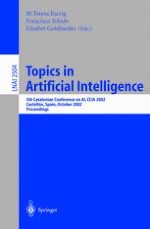2002 | OriginalPaper | Buchkapitel
Modeling Motion Qualitatively: Integrating Space and Time
verfasst von : Lledó Museros, M. Teresa Escrig Monferrer
Erschienen in: Topics in Artificial Intelligence
Verlag: Springer Berlin Heidelberg
Enthalten in: Professional Book Archive
Aktivieren Sie unsere intelligente Suche, um passende Fachinhalte oder Patente zu finden.
Wählen Sie Textabschnitte aus um mit Künstlicher Intelligenz passenden Patente zu finden. powered by
Markieren Sie Textabschnitte, um KI-gestützt weitere passende Inhalte zu finden. powered by
Motion can be seen as a form of spatio-temporal change. This concept is used in this paper to present a qualitative representational model for integrating qualitatively time and topological information for reasoning about dynamic worlds in which spatial relations between regions may change with time. The calculus here presented exploits Freksa’s notion of conceptual neighbourhood and defines a topological neighbourhood of the topological calculus about point-like, linear and areal 2D regions defined by Isli, Museros et alters. According to this, two topological relations can be called conceptual neighbours if one can be transformed into the other one by a process of gradual, continuous change which does not involve passage through any third relation. The calculus described consists of a constraint-based approach and it is presented as an algebra akin to Allen’s (1983) temporal interval algebra. One advantage of presenting the calculus in this way is that Allen’s incremental constraint propagation algorithm can then be used to reason about knowledge expressed in the calculus. The algorithm is guided by composition tables and a converse table provided in this contribution. The algorithm will help, for instance, during the path-planning task of an autonomous robot by describing the sequence of topological situations that the agent should find during its way to the target objective.
